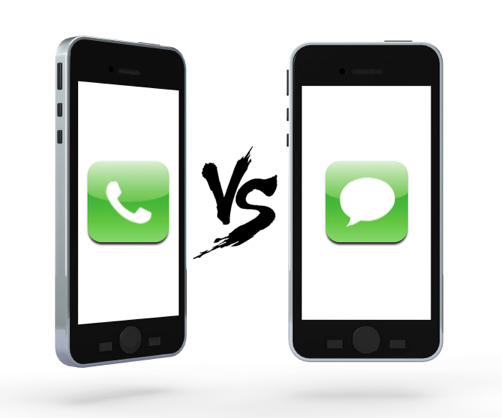The battle between picking up the phone to call someone versus texting (or instant messaging) that person is raging to new heights in today’s workplace. Before taking an allegiance, consider the below.
Most non-Millennials will urge employees to pick up the phone or walk to the person’s desk. Where as Millennials will shoot off a quick text (in-between emails, watching a company video, and texting three friends) to communicate with the person.
Before you get irate and blame an entire generation for being incapable of conversing live, let’s consider how disruptive, rude, and just plain unproductive a phone call can be.
Calling
Anatomy of Receiving a Phone Call:
05 sec: Notice call and contemplate whether or not to answer.
10 sec: Put in bluetooth or headphones (in case you have to result to multi-tasking).
01 min: Answer and salutations.
02 min: Small talk about the weather or the weekend.
03 min: Discuss message/purpose of the call.
02 min: Listen to other frivolous details/stories surrounding the main message.
30 sec: Conclusion and goodbyes.
01 min: Entertain the “Oh, one other thing…” thoughts.
15 min: Hang-up then physically and mentally switch back to the pre-call project. (A Microsoft study found it takes 15min to refocus after an interruption.)
24 minutes 45 seconds: Total Time Costs Of A Phone Call
- Phone calls are rude. Calls presume that the person you are calling should drop everything to hear what you have to say and listen to your agenda.
- Phone calls are disruptive. Calls sever focus, drawing people away from crucial projects and work flow.
- Phone calls are disjointed. Calls give the perception of more “air time” or real estate so callers neglect gathering the important points and core message prior to dialing.
- Phone calls are unproductive. Calls go unanswered. Then you leave a voicemail. They call back. You’re busy. You call back. They’re busy. Repeat all day and maybe into tomorrow. Phone tag is supremely idiotic, stressful, unproductive, and it takes up crucial mental capacity for getting real things.
VS
Texting
Anatomy of Receiving a Text:
05 sec: Notice text and ignore until current project or task is completed.
30 sec: Read text and digest content.
15 sec: Reply to text.
50 seconds: Total Time Costs Of A Text
- Texting is considerate. Text is passive communication (like email) that does not require an instant reply nor a break in focus.
- Texting is efficient. Text forces the texter to put their thoughts into words (that can be edited) and allows them to communicate the essential information for maximum efficiency.
- Texting is succinct. Text limits unnecessary salutations and irrelevant information.
- Texting is productive. Text allows users to engage and respond at their earliest convenience.
Yes Mom and Dad, sometimes a phone call is still necessary, warranted, and welcomed…even in the workplace (preferably scheduled though). But consider it the exception when communicating with Millennials.
Think text next.
Question: What best practices do you have for efficient communications?






